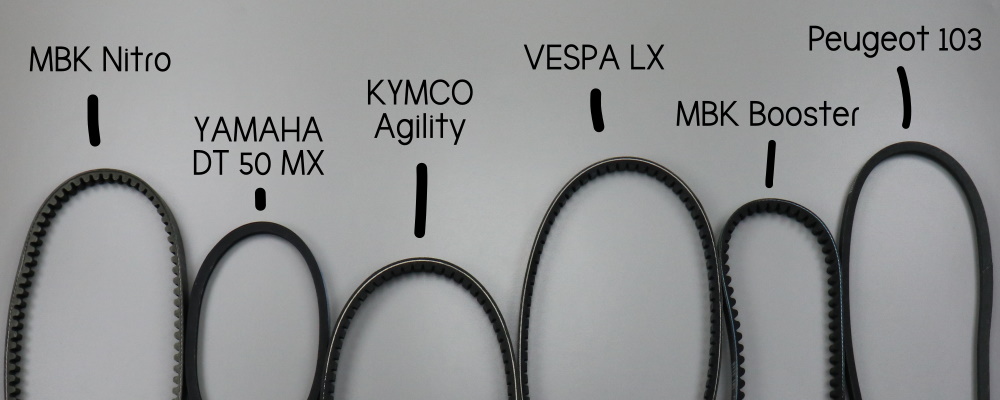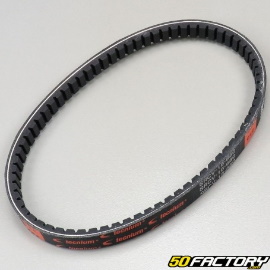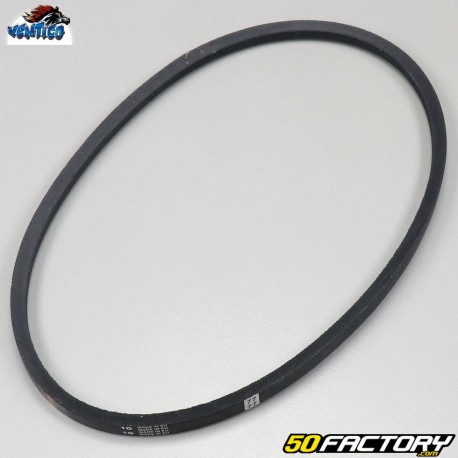
How to choose the right belt?
A loss of performance, a slipping engine, noises coming from the clutch are the signs of a weakness in the transmission belt. It is high time to check it and probably change it.
Almost all scooters and quads are equipped with a transmission belt which transmits the effort from the engine to the rear wheel.
On a scooter, the belt serves as a transmission and also a speed reducer by connecting the variator located at the output of the engine with the clutch located at the rear wheel, ensuring a variable multiplication. It is therefore trapezoidal.
Measure your belt
First, start par measure the different sides of your belt. Ideally, use a caliper to measure length (A), height (B) and thickness (C). Once you have noted these measurements, you can easily find the replacement belt you need.

The transmission belts fitted to scooter variators do not require tension adjustment, and almost zero maintenance. EThey must be replaced every 15 thousand or 000 thousand km depending on the model and according to your behavior.
Do not neglect to check it from time to time in order to prevent it from breaking during use, causing you a great risk of falling and costly repairs.
Discover our range of belts for scooters, and for mopeds on 50factory. Com.
To choose the right belt, measure the length, width and thickness of your old belt.
Examples of common models
Find out more about scooter belts
Belt Features
Resistance but also flexibility are the characteristics of the transmission belt. To force to be stretched under the stresses of acceleration or to force to slide against the "cheeks" of the variator, the resistance of the rubber eventually par diminish. The wear accelerates to the point that the structure of the belt itself sometimes ends up being damaged.ar appear.
The toothed V-belt works like a chain but with more flexibility. On the other hand, it supports low speeds and requires a lower initial tension;
The drive belt on a scooter is made of strong rubber and reinforced forar a metallic mesh or aramid fibers (Kevlar) which is particularly resistant to the wear and tear of time.
Not requiring any particular maintenance or even lubrication, the belt must however be changed fairly regularly. Its lifespan is approximately 10 000 km. The use and manner of riding your scooter increases or decreases the life of the belt. If the use is urban only, the belt will deteriorate more quickly.
Belt maintenance and change
On many scooters, it is possible to check the condition of the belt yourself, except of course if you do not have any tools or if your mechanical skills are non-existent. The manufacturers recommend that the condition of the belt be checked approximately every 6000 km.
For comparison, a motorcycle chain must be greased and tensioned every 1000 km, to be replaced every 20000 km at most.
Thanks to our tutorial, you will be able to check the condition of your belt.
To access the belt, all you have to do is remove the protective cover from the belt. Once the latter has been removed, you will be able to judge on the level of general cleanliness if the belt begins to show its first signs of weakness; in fact, a nice thickness of black dust will then have accumulated in the crankcases.
It is also necessary to check the elasticity of the belt.
Check that the belt does not fray, that there are no cracks. Check its general appearance.

Replacing the belt, on the other hand, is a more complex operation.
Replacing the transmission belt is a fairly frequent operation in the maintenance of a scooter. Follow the instructions of the tutorial complete par le video tutorial.
For the moped, follow the instructions on the written tutorial et audiovisual media
For the quad, find the explanations on the video tutorial et written
The belts are defined par their length, angle and type of material. Manufacturers offer original or reinforced type belts. Reinforced belts (kevlar, etc.) providing better performance and less wear par compared to those of the original type.
A belt that is too lightly tensioned slips and makes noise, heats up tremendously and suffers premature wear, all causing the accessories driven to malfunction.ar the belt. Excess tension causes excessive wear of the accessories driven spar the belt.
Likewise, when your belt is worn or slack, it no longer rubs properly on the pebble and this manifests itself par a significant squeak.
To make the right choice, you will need to know the type of section as well as the dimensions of the belt.
In order to determine what type of V-belt you need you will need to measure its width and thickness as shown in the diagram below, but not also the outer length which, once the type has been determined, will allow you to find the model you are looking for.













